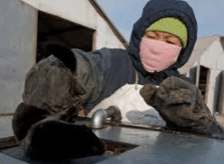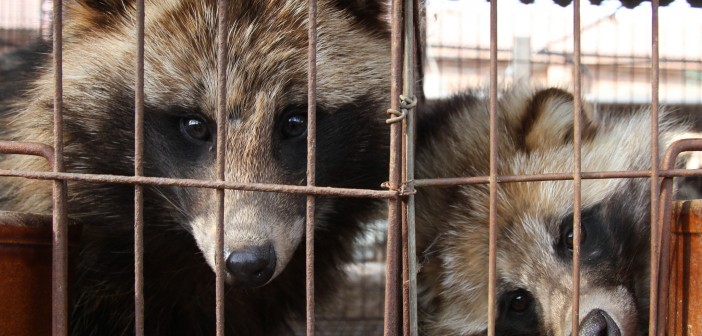(Featured image: raccoon dogs on Chinese fur farm. Credit Animal Equality International, used under CC BY-NC 2.0)
 Most fur sold globally is from farmed animals, with Europe and China being the largest producers.
Most fur sold globally is from farmed animals, with Europe and China being the largest producers.
There are countries of the EU that have a long history in fur farming and who are still continuing this practice today. And there are other countries that have moved ahead with fur farming bans: the UK, Austria, Croatia, Bulgaria and even the Netherlands which was the 3rd largest mink fur producer in Europe. But why would a country decide to ban fur farming?
 In November 2015, the report ‘The Case against Fur Factory Farming – A Scientific Review of Animal Welfare Standards and WelFur’ was launched. This scientific report concludes that ‘farming systems for mink and foxes fail to satisfy any of the Five Freedoms’ and points out that ‘the majority of European citizens, even in countries with substantial fur production, is opposed to the farming of animals for fur in cages’. To further support this, the December 2015 Czech Republic’s opinion poll indicated 70% of people were in favour of a ban on fur farming and 85% said they don’t buy fur!
In November 2015, the report ‘The Case against Fur Factory Farming – A Scientific Review of Animal Welfare Standards and WelFur’ was launched. This scientific report concludes that ‘farming systems for mink and foxes fail to satisfy any of the Five Freedoms’ and points out that ‘the majority of European citizens, even in countries with substantial fur production, is opposed to the farming of animals for fur in cages’. To further support this, the December 2015 Czech Republic’s opinion poll indicated 70% of people were in favour of a ban on fur farming and 85% said they don’t buy fur!
Experts from a wide variety of fields commented on the report and condemned the practice of fur farming in today’s Europe.
 ‘The 2001 report from the Scientific Committee on Animal Health and Welfare concluded that the housing systems cause serious animal welfare problem for the animals kept on fur farms. Nothing has changed in today’s fur farms’ said Mark Glover, Campaigns Director from the UK based NGO Respect for Animals. This view is supported by Professor Stephen Harris who is the co-author of the report.
‘The 2001 report from the Scientific Committee on Animal Health and Welfare concluded that the housing systems cause serious animal welfare problem for the animals kept on fur farms. Nothing has changed in today’s fur farms’ said Mark Glover, Campaigns Director from the UK based NGO Respect for Animals. This view is supported by Professor Stephen Harris who is the co-author of the report.
Inez Staarink, Policy Advisor on Agriculture, Nature, Animals and Food – Dutch Parliament, has spoken about the process of banning fur farming in the Netherlands. She recommended that MEPs follow their example and support bans in the Member States, to prohibit the expansion of fur farms and to get correct labeling of fur products. ‘We should not export fur, we should export bans on fur farming’ she concludes. Germany seems to be seriously considering this idea with draft legislation being discussed in order to ban fur farming in the country and Denmark has banned fox fur farming since 2009 (with a 15 year phase out period).
 Following all these developments within Europe, the report and all the recent information on the toxic chemicals repeatedly found in both adult and children’s clothing that pose a threat to human health, the question of whether China will follow Europe’s mistakes or learn from them is more important now than ever before. The spotlight is on China and its consumers to soon make a wise, bold and ethical decision with regards to fur farming.
Following all these developments within Europe, the report and all the recent information on the toxic chemicals repeatedly found in both adult and children’s clothing that pose a threat to human health, the question of whether China will follow Europe’s mistakes or learn from them is more important now than ever before. The spotlight is on China and its consumers to soon make a wise, bold and ethical decision with regards to fur farming.





